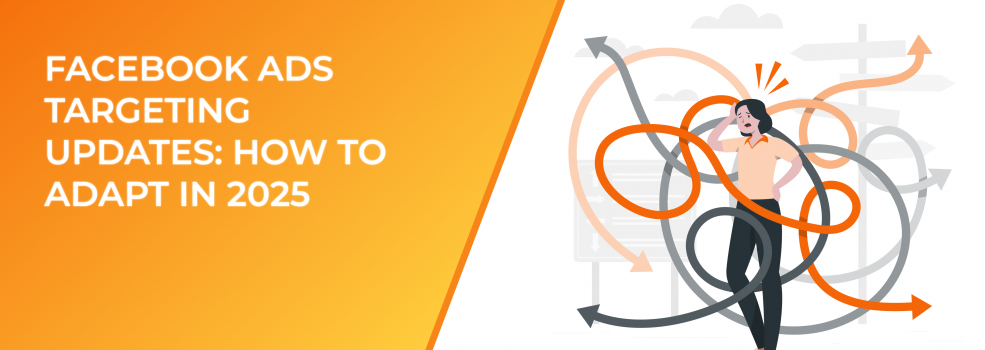Meta’s advertising landscape is shifting, and the pace is only getting faster. From the removal of Detailed Targeting Exclusions to stricter rules for customer lists and expanded location targeting, these Facebook ad targeting updates could mean a lot for your campaigns.
But don’t panic: every change Meta introduces is designed to improve efficiency, transparency, or compliance. As an advertiser, that means there’s opportunity behind every new policy if you know how to adapt.
In this article, we’ll break down what these changes mean, why they’re happening, and most importantly, how to tweak your strategy to stay ahead. Let’s dive in.
No more Detailed Targeting Exclusions
In 2024, Meta began phasing out Detailed Targeting Exclusions in ads. This phaseout started on July 29th and will reach its final stage on 31 January this year – the campaigns using these exclusions will stop being delivered.
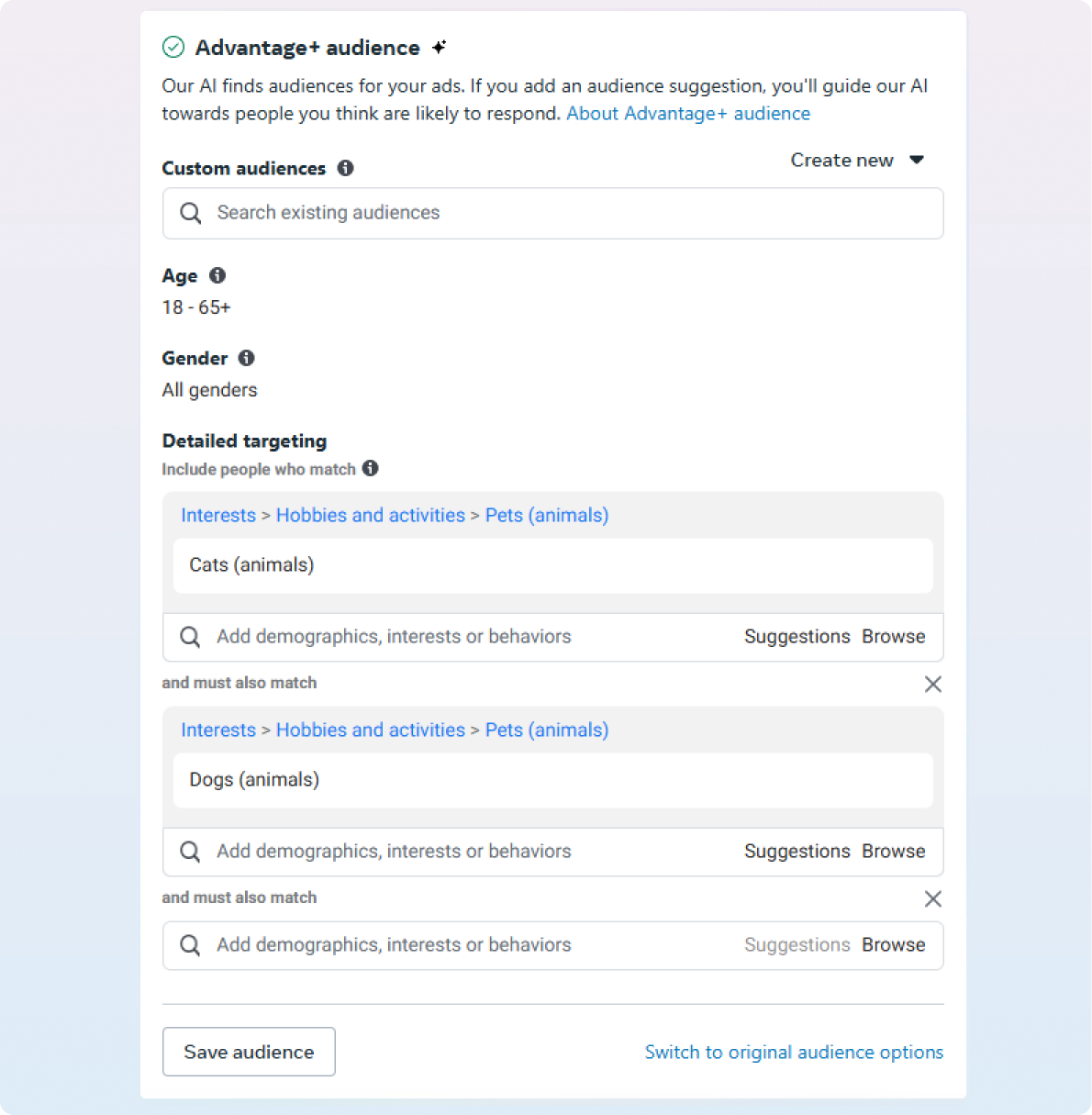
The option to exclude people is no longer available in the “Detailed targeting” section.
But what does this mean for you as an advertiser? Let's dive into it.
Why is Meta making these changes?
Many advertisers relied on detailed targeting exclusions to refine their audiences. For example, these exclusions allowed excluding people who have already purchased from you, making sure that specific behaviors, interests, or demographics weren’t included, and so on. Thanks to this feature, advertisers could make sure that they’re not targeting people who aren’t likely to become their customers.
However, based on Meta’s data, it turns out this feature might not be as necessary as we thought.
Meta found that when advertisers didn’t use detailed targeting exclusions, the average cost per conversion was lower. In fact, Meta’s 100% sure that removing exclusions led to more cost-effective conversions — a compelling reason for the change.
What does this mean for advertisers?
If you were regularly using these exclusions for your campaigns, don’t panic — their removal might actually work in your favor.
Facebook’s updated targeting algorithms are designed to optimize your ads for conversions – the main goal is to find the right people even if they don’t fall into your preferred audience.
When you let the algorithm do its job without narrowing down your audience too much, it can find more potential customers and subsequently reduce your Facebook ads costs.
That’s why Meta is also actively pushing for its Advantage Detailed Targeting, which has become the default option for campaigns with certain performance goals (link clicks and landing page views) – the trend is clear.
Considering this, excluding certain groups or users might seem like a good idea, especially if you're targeting the top of the funnel (clicks, engagement). However, it may actually be a temporary fix rather than a long-term solution.
And with the way Facebook’s targeting algorithms work, restricting your audience can limit their ability to learn and optimize.
The takeaway: focus on the bigger picture
Meta’s move towards removing detailed targeting exclusions is a step toward making ads more automated and efficient (from Meta’s point of view).
Since these exclusions were removed completely and you can’t enable them back on, it’s best to lean into audience expansion and let Meta’s algorithms find the right people for you. These algorithms become better as the time goes, so it might be the time to let them do their job.
So, detailed targeting exclusions might not be necessary for driving cost-effective conversions anymore, and you could see better results without them.
However, keep in mind that you can still use exclusions with custom audiences. You can also make sure you’re not targeting certain groups of people by setting audience controls for your Ad Account.
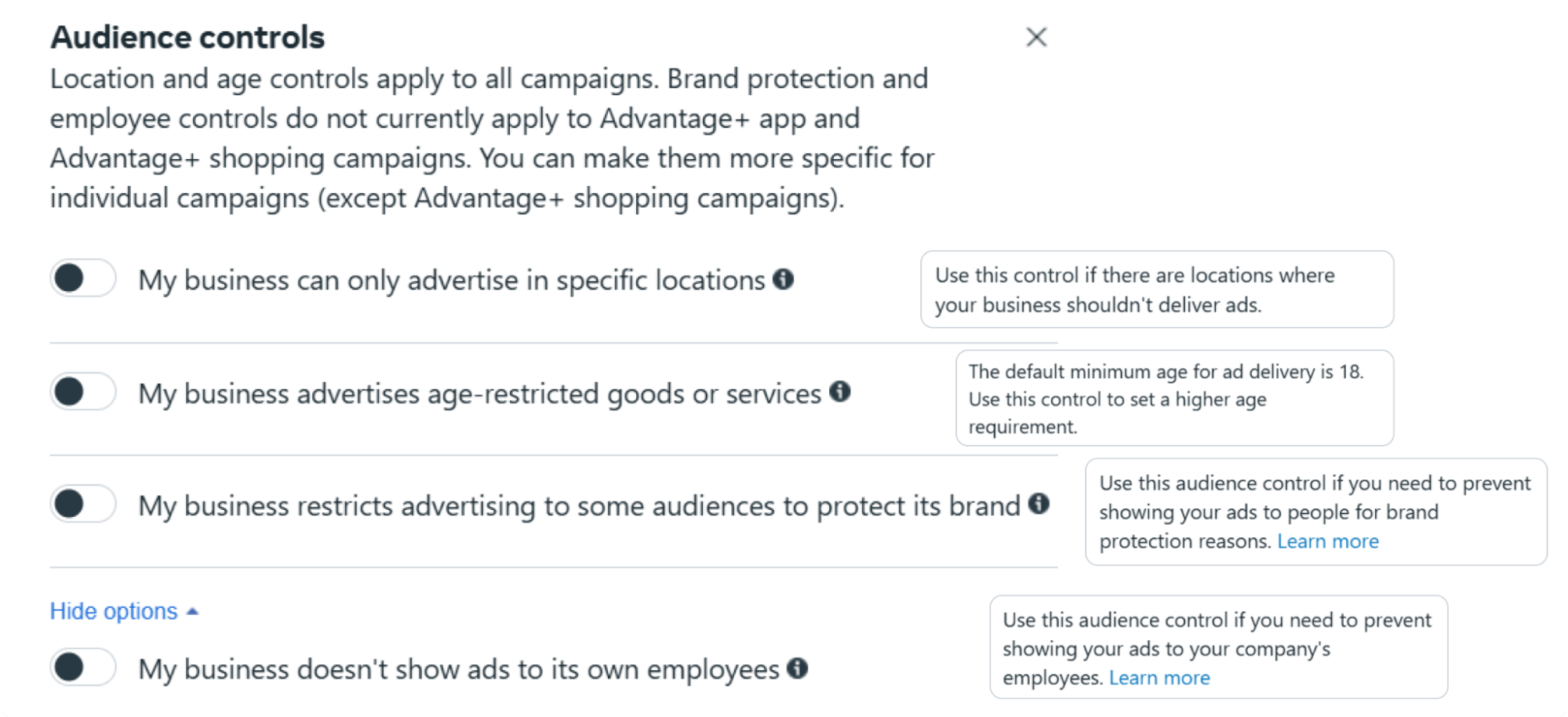
There are four main audience controls you can set: age, location, brand protection, and employment.
These controls let you limit your audience based on age and location (for all campaigns), as well as brand protection and employment (for all campaigns except Advantage+ shopping and Advantage+ app campaigns). There’s also an option to adjust these controls to specific campaigns except the Advantage+ shopping ones.
Still, if you’re worried about losing control over who sees your ads, tools like LeadEnforce can help bridge the gap. LeadEnforce lets you build custom audiences based on activity in specific Facebook groups or Instagram accounts, giving you a more relevant starting point for campaign optimization, even as Meta automates more of the process.
Customer list custom audiences will be restricted (US only)
In 2025, there will also be new restrictions on customer list custom audiences for housing, employment, and financial products (including credit) campaigns in the US only. Announced in October 2024, these changes will take full effect in March 2025 – you have some time to adapt to the updated rules if you’re using this type of custom audiences.
Why is Meta making this change?
Customer lists have been a go-to tool for advertisers targeting niche audiences because they allow brands to upload specific data and target potential customers with precision.
Now, Meta is tightening its policies to align with its terms and Advertising Standards, especially for sensitive categories like housing, jobs, and financial services.
The main goal is to reduce misuse of customer data and ensure compliance with advertising regulations. This means advertisers will need to follow stricter rules when using customer lists in these categories.
What does this mean for advertisers?
Starting in early March 2025, any new or edited campaigns in these categories must use customer lists that meet Meta’s updated requirements. If your lists don’t comply, Ads Manager will show you error messages with instructions.
For campaigns already running, you have until late March 2025 to update your customer lists. After that, non-compliant campaigns may be paused and you’ll also see errors in your Ads Manager.
Shared customer lists are also getting an overhaul. Advertisers will no longer be able to use customer lists that were shared by Consumer Reporting Agencies (or CRAs), and these CRAs won’t be able to use their own customer lists for running these types of ads.
If you use customer list custom audiences, you’ll have to certify that your customer lists don’t use consumer report information, as well as other types of data that is sensitive or prohibited by law or by Meta’s terms and policies. Certification tools will roll out in Ads Manager starting March 2025.
The takeaway: prepare your customer lists in advance
These new restrictions are designed to make advertising on Facebook more transparent and compliant. If you’re running campaigns in the mentioned categories, take time to review your customer lists to ensure that your data meets Meta’s updated requirements and be prepared to complete the certification process in Ads Manager when it becomes available.
Also, If you rely on customer lists shared by other businesses and especially consumer reporting agencies, it’s time to rethink your strategy and find ways to use your own data.
Special ad categories will include financial products and services
There’s another change that concerns specific ad categories. Starting last year, a new category called Financial Products and Services is replacing the old “Credit” category. Basically, from now on, special ad categories will include ads promoting products like insurance, bank accounts, investment services, and payment platforms.
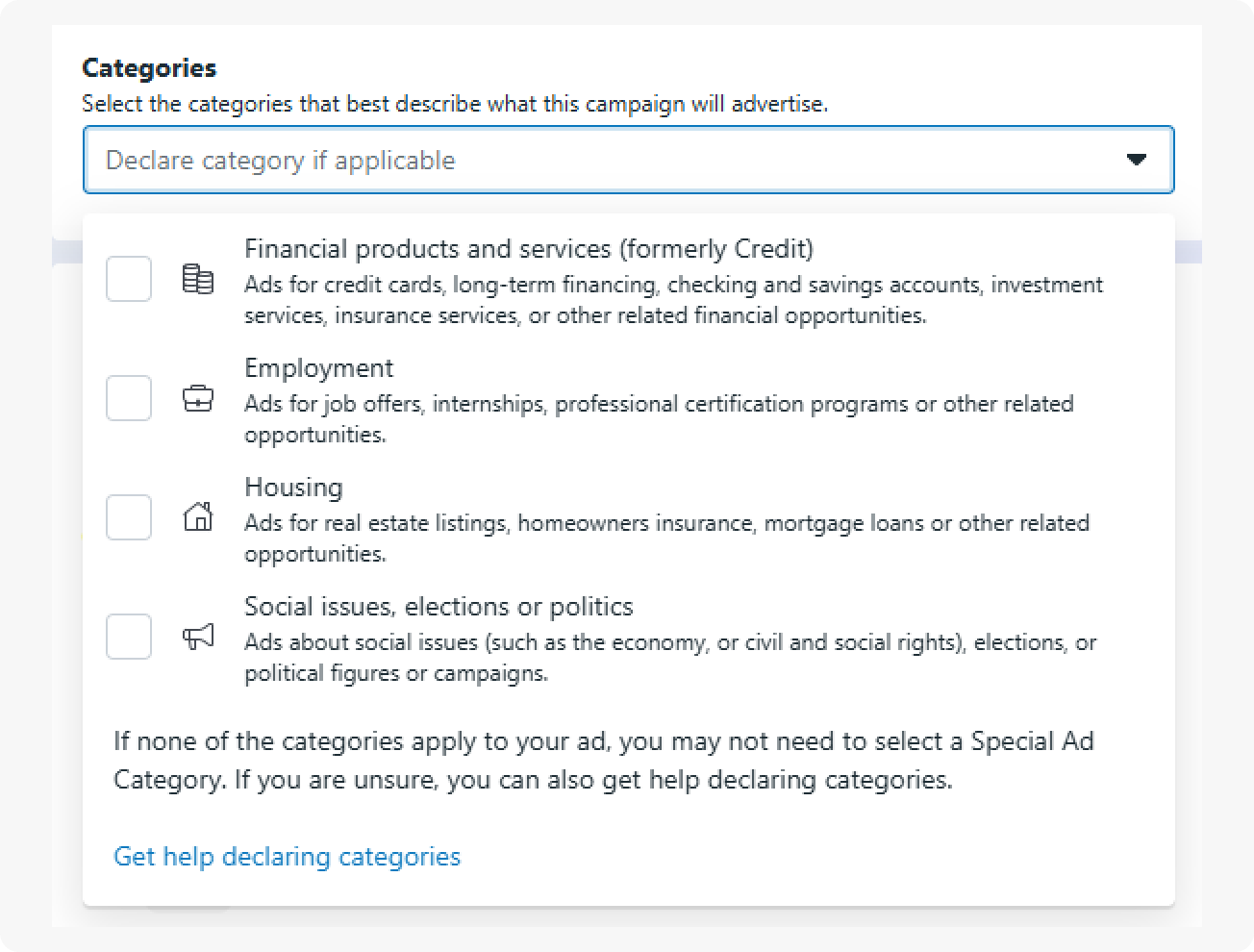
Credit ads, as well as ads about more finance-related services, now belong to the “Financial products and services” category.
Why is Meta making this change?
Like other updates, this one is meant to enhance advertising fairness, ensure compliance, and improve user experience.
Ads in special categories come with stricter audience targeting options, which helps ensure that there’s no discrimination in the ways ads will be delivered. Also, limiting misleading ads and enhancing transparency improves the overall experience for users.
What does this mean for advertisers?
Beginning in early 2025, selecting the Financial Products and Services category will no longer be optional for advertisers in the U.S. or those targeting U.S. audiences. If your campaign involves financial products and you don’t choose this new ad category, your ads may be rejected.
But there’s more: like all other special ad categories, this new one limits your audience targeting options. You won’t be able to use certain detailed targeting and location targeting options. Lookalike audiences are also off the table for this ad category.
This means that advertisers will have to work within narrower parameters. If you’re used to fine-tuned targeting, you’ll need to adjust your approach.
If you’re affected by the removal of lookalike audiences in sensitive categories, consider alternative solutions. For example, LeadEnforce allows you to build high-intent custom audiences by analyzing group-level activity — a smart workaround when Meta’s built-in Lookalikes are no longer an option.
Don’t forget: the rules for credit ads (a subset of financial products) aren’t changing. If you’re targeting the U.S., Canada, or parts of Europe, you should abide by the same policies as before.
The takeaway: get ready for changes
If you’re in the business of promoting financial products or services, it’s time to prepare. Start learning the rules for the new Financial Products and Services category and planning how to work within more limited targeting options, and make sure to select the appropriate category to avoid ad rejections.
While this update may seem restrictive, it’s a step toward a more transparent and trustworthy advertising environment on Meta’s part — one you’ll want to stay on the right side of.
Location targeting gets expanded
As we’ve said, Meta actively pushes advertisers to choose broad targeting over narrow options, and now it includes targeting based on location as well. The latest change to location targeting aims to help businesses — especially those in travel, retail, and hospitality — reach audiences more effectively.
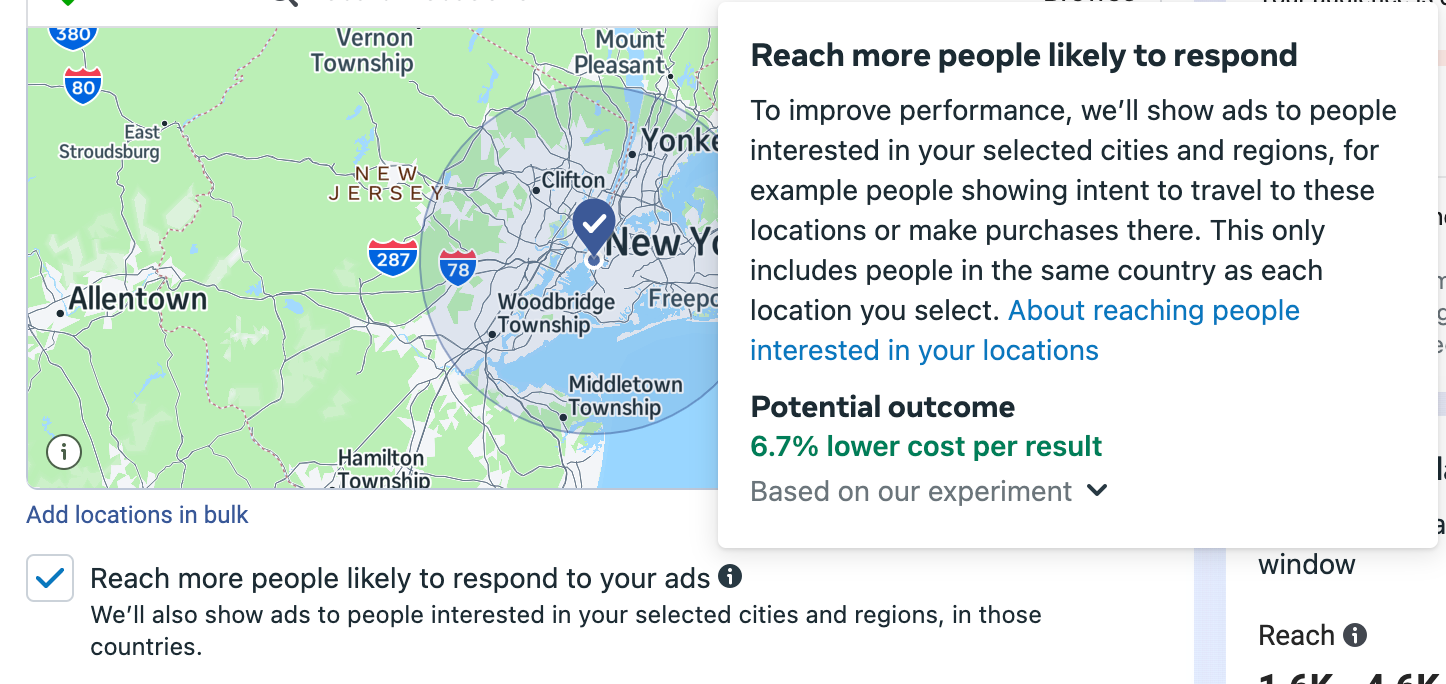
If you want to reach potential customers who don’t live in your location but have connections to it, try location expansion targeting in your Ads Manager.
What does this mean for advertisers?
Advertisers targeting specific cities or regions can now use the “Reach more people likely to respond to your ads” feature. This feature allows Meta to find people who’ve shown an interest in your selected location based on their recent visits, searches, interactions with other ads, and social connections.
This includes users who:
- Recently visited or lived in this location;
- Searched for related terms or Marketplace listings;
- Interacted with ads or Pages about the area;
- Have friends in the area;
- Live in nearby towns or cities.
This expanded targeting only applies within the same country as your selected location and is automatically enabled when you select specific cities/regions.
According to Meta, this feature has proven benefits: advertisers using it saw a lower cost per result, which confirms that targeting expansions might work better for certain businesses.
Use cases include:
- Travel: Attract travelers seeking accommodations, activities, or experiences in your target area.
- Entertainment: Promote concerts, events, and activities in specific locations.
- Retail: Drive foot traffic to physical stores by targeting potential shoppers interested in your region.
- Professional Services: Reach clients interested in real estate, legal advice, or consulting services in your area.
- Restaurants: Encourage travelers to dine in your establishment or use food delivery services.
However, this isn’t a one-size-fits-all solution. As in the case of other audience expansion features, this one can make targeting less precise. If you’re advertising in niches that rely on geographical precision, you may want to disable this feature.
The takeaway: if it fits your goals, use it
Should you use location expansion? For most advertisers, the answer is yes if you want to reach more people and precise location targeting is not crucial for your business.
This feature gives Meta the flexibility to optimize your audience without radically shifting your budget – it’s a good opportunity to find new profitable segments to show your ads to. But, as always, monitor performance to ensure it aligns with your goals.
Conclusion
Facebook targeting updates may seem like a shake-up, but they’re actually a chance to refine your advertising strategy. Whether it’s relying on smarter algorithms, updating your customer lists, or broadening your audience targeting, these changes are designed to help you connect with your audience in new ways.
The secret? Stay adaptable. Treat these updates as a chance to test, innovate, and uncover strategies that deliver results. As Meta’s platform evolves, the most successful brands will be the ones that evolve right alongside it.
Take a moment, adjust your approach, and turn these updates into your next opportunity.
